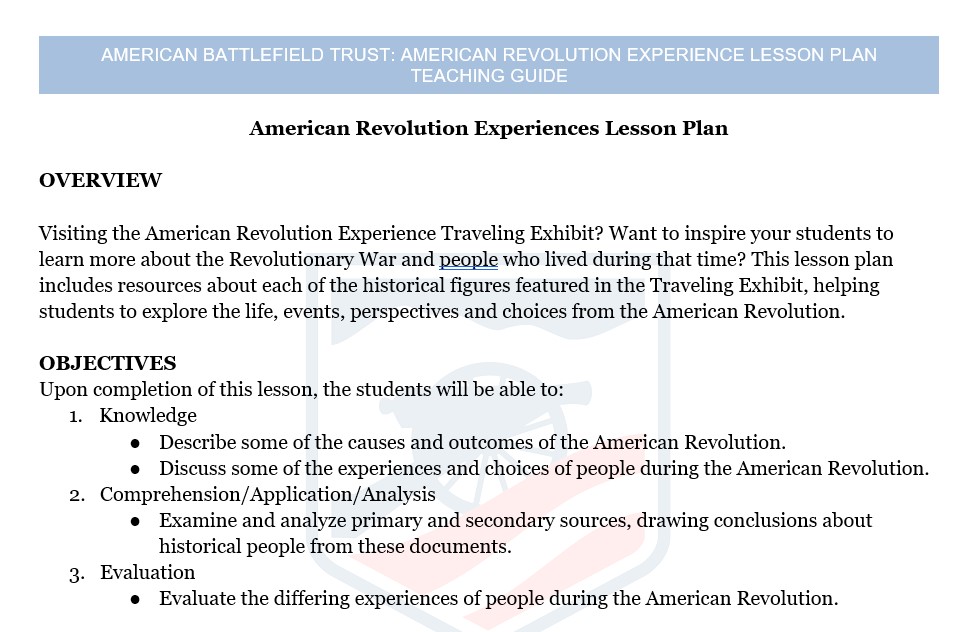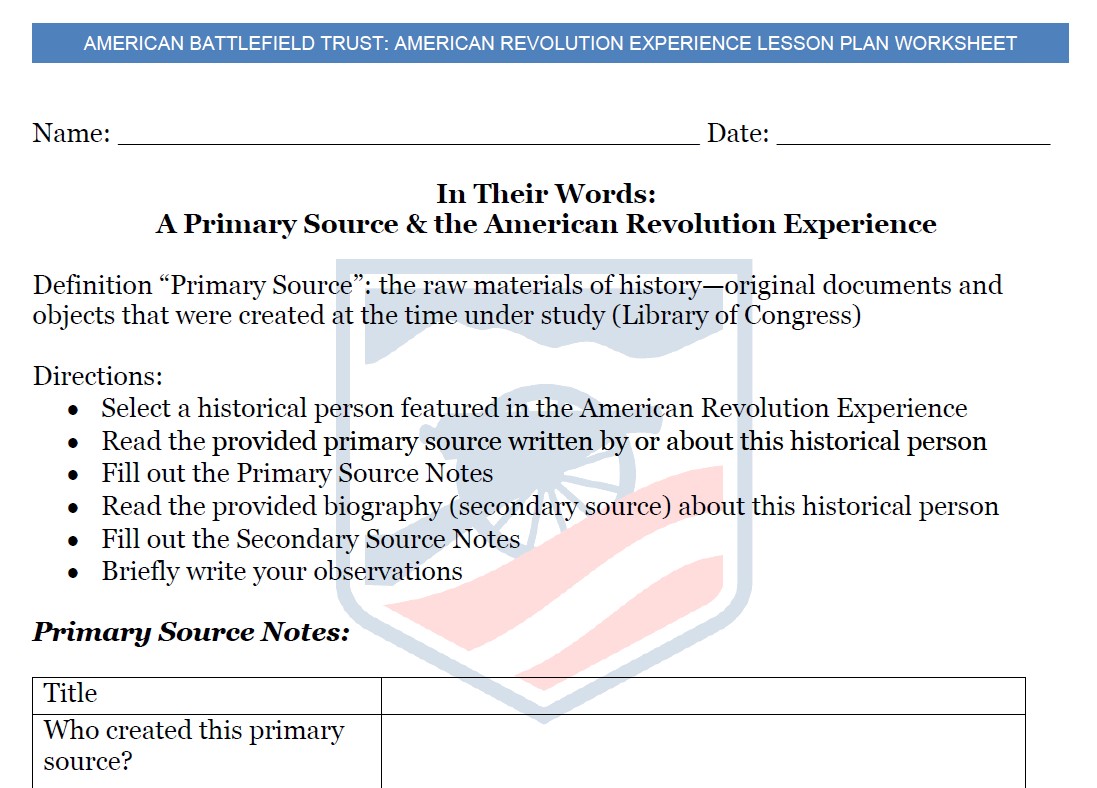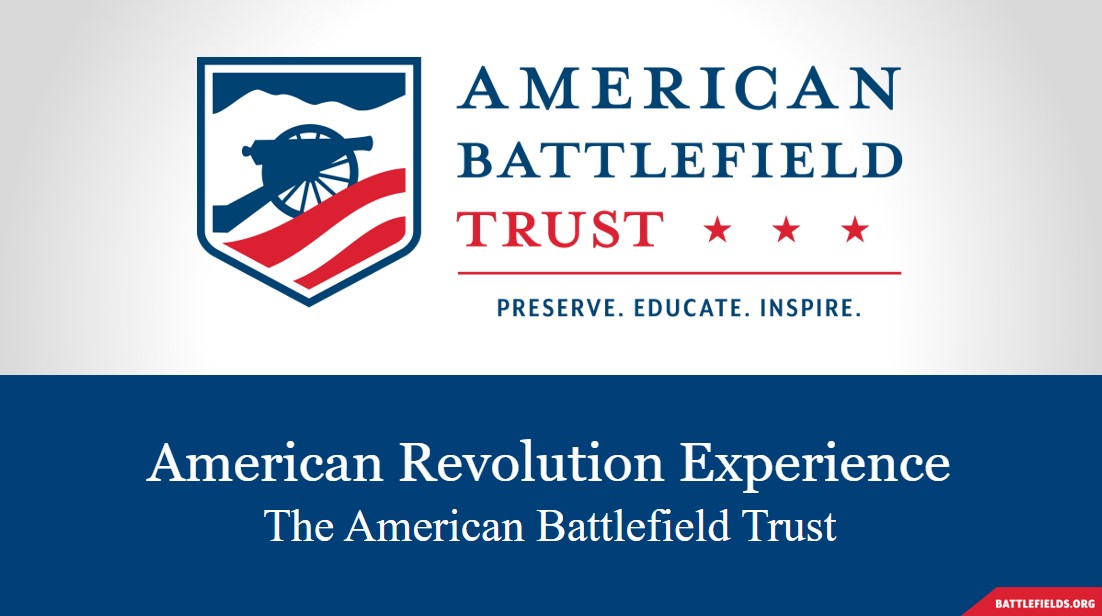
The American Revolution Experience Traveling Exhibit at DAR Headquarters in Washington, DC
Revolutionary War Experience Lesson Plan
A lesson plan for use in middle and high school classrooms.
Visiting the American Revolution Experience Traveling Exhibit? Want to inspire your students to learn more about the Revolutionary War and people who lived during that time? This lesson plan includes resources about each of the historical figures featured in the Traveling Exhibit, helping students to explore the life, events, perspectives and choices from the American Revolution.
This Lesson Plan can be used as a prepared resource by following this curriculum plan which aligns to NCSS and Common Core Standards.
Upon completion of this lesson, the students will be able to:
1. Knowledge
- Describe some of the causes and outcomes of the American Revolution.
- Discuss some of the experiences and choices of people during the American Revolution.
2. Comprehension/Application/Analysis
- Examine and analyze primary and secondary sources, drawing conclusions about historical people from these documents.
3. Evaluation
- Evaluate the differing experiences of people during the American Revolution.
Check out the Lesson Plan Teaching Guide for more instructions on using the prepared Lesson Plan.
Lesson Plan Primary & Source Activity:
- Watch The Revolutionary War Animated Map video.
- Use the Lesson’s PowerPoint to explore the context and history; the PowerPoint lays foundational knowledge about the conflict.
- Visit The American Revolution Experience Traveling Exhibit and remind students to choose a historical figure that they would like to learn more about.
- After the exhibit visit, distribute the primary and secondary source worksheet.
- In groups or individually, have the students read the primary source and biography for the person they want to research.
- Selected primary sources and biographies are available on the Lesson Plan Page.
- Have the students fill out the worksheet; encourage them to share some of the details and their observations with the rest of the class.
Common Core State Standards- ELA & History/Social Studies
Grades 6-8
- Key Ideas and Details:
- CCSS.ELA-LITERACY.RH.6-8.2
- Determine the central ideas or information of a primary or secondary source; provide an accurate summary of the source distinct from prior knowledge or opinions.
- CCSS.ELA-LITERACY.RH.6-8.2
- Craft and Structure:
- CCSS.ELA-LITERACY.RH.6-8.6
- Identify aspects of a text that reveal an author's point of view or purpose (e.g., loaded language, inclusion or avoidance of particular facts).
- CCSS.ELA-LITERACY.RH.6-8.6
- Integrations of Knowledge and Ideas:
- CCSS.ELA-LITERACY.RH.6-8.9
- Analyze the relationship between a primary and secondary source on the same topic.
- CCSS.ELA-LITERACY.RH.6-8.9
Grades 9-10
- Key Ideas and Details:
- CCSS.ELA-LITERACY.RH.9-10.1
- Cite specific textual evidence to support analysis of primary and secondary sources, attending to such features as the date and origin of the information.
- CCSS.ELA-LITERACY.RH.9-10.2
- Determine the central ideas or information of a primary or secondary source; provide an accurate summary of how key events or ideas develop over the course of the text.
- CCSS.ELA-LITERACY.RH.9-10.1
- Craft and Structure:
- CCSS.ELA-LITERACY.RH.9-10.5
- Analyze how a text uses structure to emphasize key points or advance an explanation or analysis.
- CCSS.ELA-LITERACY.RH.9-10.5
- Integrations of Knowledge and Ideas:
- CCSS.ELA-LITERACY.RH.9-10.9
- Compare and contrast treatments of the same topic in several primary and secondary sources.
- CCSS.ELA-LITERACY.RH.9-10.9
Grades 11-12
- Key Ideas and Details:
- CCSS.ELA-LITERACY.RH.11-12.2
- Determine the central ideas or information of a primary or secondary source; provide an accurate summary that makes clear the relationships among the key details and ideas.
- CCSS.ELA-LITERACY.RH.11-12.3
- Evaluate various explanations for actions or events and determine which explanation best accords with textual evidence, acknowledging where the text leaves matters uncertain.
- CCSS.ELA-LITERACY.RH.11-12.2
- Craft and Structure:
- CCSS.ELA-LITERACY.RH.11-12.6
- Evaluate authors' differing points of view on the same historical event or issue by assessing the authors' claims, reasoning, and evidence.
- CCSS.ELA-LITERACY.RH.11-12.6
- Integrations of Knowledge and Ideas:
- CCSS.ELA-LITERACY.RH.11-12.8
- Evaluate an author's premises, claims, and evidence by corroborating or challenging them with other information.
- CCSS.ELA-LITERACY.RH.11-12.9
- Integrate information from diverse sources, both primary and secondary, into a coherent understanding of an idea or event, noting discrepancies among sources.
- CCSS.ELA-LITERACY.RH.11-12.8
Social Studies - National Council for the Social Studies
- Theme 1: Culture
- Theme 2: Time, Continuity, and Change
- Theme 3: People, Places, and Environments
- Theme 4: Individual Development and Identity
- Theme 5: Individuals, Groups, and Institutions
- Theme 6: Power, Authority, and Governance
This Lesson plan
contains the following:
1 Activities | 42 Resources
Audience: Middle school | High school


